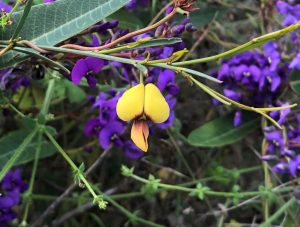Australian Pea Flower SG newsletter, no.4, December 2022

The newsletter introduces the “eggs and bacon” peas and provides a guide to identifying them. Genera involved are Pultenaea, Dillwynia, Aotus, Daviesia and Eutaxia. The Pilliga and Warrumbungles tours included on the APS conference program in September, provided good hunting for pea flowers. Stars were Pultenaea cinerascens in the Pilliga and Indigofera adesmiifolia in the Warrumbungles, where Templetonia stenophylla also made an appearance.
Shirley McLaran reports on a road trip to Melbourne to attend the FJC Rogers “Fabulous Peas” seminar in October, capturing range of pea flowers both roadside and in reserves. An account is provided of the seminar, which included a range of speakers and several garden visits, both public and private. Study group contact is fabpeamail@gmail.com
Acacia SG newsletter, no 153, December 2022
It’s reported that Acacia pycnantha has been the subject of a DNA sequencing study. The research team hopes to investigate the relationships between all wattle species. Acacia dealbata and baileyana have spread to become pests in central Victoria, and the two species are crossing to produce hybrids. There is a campaign to discourage people in the area from planting these species in their gardens. Peter Goldup (Vic.) is developing some smaller forms and colour variants of various acacia species, which look very attractive. The newsletter reports on the quite extensive Wattle Day activities across Australia in 2022. Australian embassies overseas also participated. Study group contact is acaciastudygroup@gmail.com
Grevillea SG newsletter, no.124, February 2023

Neil Marriott reports that all plants of Grevillea gariwerdensis at its type location at Halls Gap, were destroyed by a wildfire and it was thought to be extinct at that location. However a recent field trip resulted in the discovery of several hundred seedlings.
Grevilleas can display the ability to colonize from nearby garden plantings. Examples of G. arenaria ssp. canescens, G. sericea ssp. sericea, and G. alpina apparently spreading from gardens are cited from Victoria.
G. barklyana is a well-known robust screening shrub. Peter Olde discusses G. barklyana and related species and concludes that the form commonly in cultivation is a hybrid originally introduced as “Barkly’s Daughter”.
G. trifida, a WA plant, has been successfully propagated from cuttings by Margaret Pieroni and grown on in her garden. Seeds have also been sown but have yet to show any germination!
G. vestita “Mulberry Midnight” is another WA plant, white-flowered but with mulberry-black buds. This form was collected from an area of Perth since cleared by developers. A range of other beautiful Grevillea selections are illustrated in the newsletter. Grevillea fanciers have a treat in store as Marriott and Olde’s book on grevillea hybrids is now at the publishers. Study group contact is Christine Guthrie at bruce.moffatt@tpg.com.au
Wallum SG newsletter, no.54, March 2023
Robert Price provides a list of wallum/heathland plants growing at his and Linda’s garden in Tewantin, Qld, categorised as wet or dry heath types. Unsuccessful attempts are also reported. Overall a 71% success rate has been achieved. Jenny Gursanscky reports on wildflower sightings during a 6 day hike in the Tarkine, Tas. Christmas bells (Blandfordia punicea) were a standout. Study group contact is carr.allan44@gmail.com
Fern SG newsletter, no.153, March 2023
There are very active excursion and get-together programs run by this group in the Sydney and SE Queensland regions. A dozen “fernies” travelled to the Port Macquarie region recently, to view ferns growing in national parks. Boorganna Nature Reserve, Werrikimbe National Park, and Dorrigo National Park yielded more than 30 species per location. Seeing filmy ferns (Hymenosporum spp etc.) was one of the highlights. Study group contact is ANPSAferns@bigpond.com
Hakea SG newsletter, no.81, February 2023
Phytophthora disease and the potential use of phosphorous acid for prevention are discussed in the newsletter. It may be a good idea to spray some of our more delicate Hakea species at 6 week intervals. There are some Hakea species which are fungus-resistant, and building up raised beds and improving drainage will help. A resistant group of species is described. These are H. nodosa, H. propinqua, and H. pachyphylla, which grow naturally in the eastern states. Study group contact is hakeaholic@gmail.com
